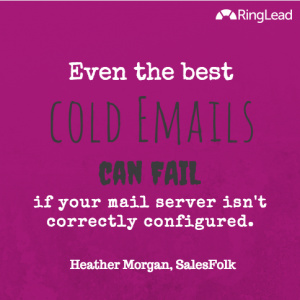Big fish enterprise customers are a dream to chase given the high dollar values of their accounts, but due to long sales cycles and high acquisition costs, some B2B businesses may lose money on short-term engagements and only achieve profitability on the account when the client renews their contract.
Given the risks involved with losing these major clients, organizations should go to great lengths to ensure these accounts remain happy and healthy. It may seem like an account management and customer service issue, but potential problems can present themselves much earlier in the relationship and it is initially up to the sales team to serve as the first line of defense.
Customer service starts in sales
Good prospect qualification to establish the fit of a potential client is not only beneficial for forecasting within the sales team, but helps ensure a smooth transition into the service side of the business post-sale.
Diagnosing the prospect’s needs to accurately set expectations mitigates the risk of miscommunication which can cause a rift over time. This should include capabilities of the product itself, but the level of service to expect during implementation and later once up and running.
Once the hand-off has been made, it is incumbent on your accounts and customer service team to deliver on the promises made by your sales reps. The two departments must be closely aligned to ensure neither party misrepresents the capabilities of the other, and many organizations adopt internal service level agreements between teams so there is no ambiguity around who is responsible for what.
Open communication should be a priority
As customers ramp up, it is important to understand who the internal stakeholders are and what performance metrics matter to each of them. Any good service relationship relies on regular check-ins, but the content and frequency of each depend on the audience.
Many accounts have very hands-on users who demand weekly contact with their vendors. Managerial teams, on the other hand, prefer to be behind the scenes, are less concerned with day-to-day happenings and are more interested in the overall monthly or quarterly performance of the engagement. When appropriate, it is important to foster strong relationships with the executive team, though consider that their time is sensitive and interests are geared toward understanding the broader ROI generated on their investment.
Regular check-ins tailored to the audience are vital in ensuring that all parties within an organization, from top to bottom, see the impact your product or service provides in the language they care about. If done effectively the decision to renew for a subsequent contract feels less like a coin flip and more like a foregone conclusion as there has been clarity since day one.
Do not stop selling
Assuming that your sales philosophy is aligned with a customer-first approach, persistent upselling is not motivated by the desire to squeeze every penny of lifetime value from a client, but to continue solving user problems. For some accounts, the sales team stays on through the full duration of the engagement, but even if there is a transition to the service team there remains a responsibility to stay in tune with shifting needs.
A customer often initiates a relationship with a vendor with starting goals that evolve over time. If these can be monitored during the lifetime of an account, there is an opportunity to expand the scope of work or product configuration in a way that further increases the value the client receives.
A business in the market for a CRM would presumably increase their usage and technological sophistication as their own sales grow, so while marketing automation may have been inappropriate for their database in the early stages they may scale to the point where operational efficiency is hindered without it. The sales or service reps who are in tune with these growing pains can present a solution when the time is right and expect it to be viewed with appreciation rather than skepticism.
Surprise and delight
Though the tactic of “surprise and delight” may have been born for marketers to wow their audience (and drum up great buzz) with viral-worthy stories of consumer outreach, there is no reason not to apply the maxim to existing customers.
The possibilities are limited only to the service team’s creativity, but clever leaders recognize the value of exception and unexpected service and have cooked up everything from co-marketing options like joint webinars, to personalized swag that will turn recipients into product advocates.
A branded stress ball sent to every major account is neither surprising nor likely to be used for anything greater than a desk toy. Worse, it will only be visible to the coworkers of someone who is already a customer, creating little opportunity to spread positive word of mouth to new potential customers. On the other hand, purchasing your customer a conference ticket to an event with education tracks useful in their career will not only be a shocker, but will surely give them a chance to share the story with others.
Not every surprise needs to break the budget, but understanding your customer’s business and personal interests is always a fast path to staying in their good graces. Much of keeping enterprise customers happy lies in embodying the Golden Rule we were all taught as children: treating them the way you would want to be treated ensures good experiences, and going above and beyond never goes unnoticed.
Business & Finance Articles on Business 2 Community(110)
Report Post




